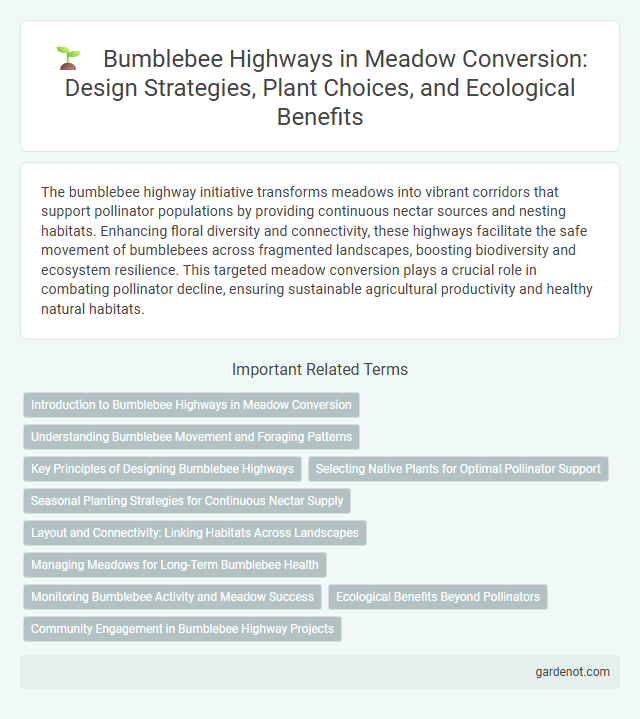The bumblebee highway initiative transforms meadows into vibrant corridors that support pollinator populations by providing continuous nectar sources and nesting habitats. Enhancing floral diversity and connectivity, these highways facilitate the safe movement of bumblebees across fragmented landscapes, boosting biodiversity and ecosystem resilience. This targeted meadow conversion plays a crucial role in combating pollinator decline, ensuring sustainable agricultural productivity and healthy natural habitats.
Introduction to Bumblebee Highways in Meadow Conversion
Bumblebee highways are designated corridors of wildflower-rich meadows established to support native bumblebee populations by enhancing their foraging habitats. These meadow conversions increase floral diversity and provide continuous nectar sources, crucial for sustaining bumblebee colonies throughout their active seasons. Implementing bumblebee highways in agricultural landscapes promotes pollinator biodiversity and contributes to ecosystem resilience.
Understanding Bumblebee Movement and Foraging Patterns
Bumblebee movement and foraging patterns are influenced by landscape features such as the Bumblebee highway, a strategically planted corridor of wildflowers that enhances connectivity between meadows. This highway supports efficient navigation and resource access by providing continuous floral resources and nesting habitats, crucial for sustaining bumblebee populations. Studies using GPS tracking and pollen analysis reveal that bumblebees prefer routes with diverse flower species and shorter travel distances, optimizing energy use during foraging.
Key Principles of Designing Bumblebee Highways
Designing bumblebee highways requires incorporating native flowering plants that provide continuous nectar sources throughout the bumblebee active seasons, supporting their foraging needs and colony development. Ensuring habitat connectivity by linking fragmented green spaces facilitates safe navigation and genetic exchange among bumblebee populations. Additionally, minimizing pesticide use and maintaining diverse floral structures create an optimal environment that enhances bumblebee biodiversity and ecological resilience.
Selecting Native Plants for Optimal Pollinator Support
Selecting native plants such as goldenrod, milkweed, and coneflower for the Bumblebee Highway enhances pollinator habitat by providing essential nectar and pollen sources throughout the growing season. These species support diverse pollinator populations, including bumblebees, by ensuring continuous bloom and nutritional variety. Incorporating native plants improves ecosystem resilience and sustains local biodiversity within meadow conversions.
Seasonal Planting Strategies for Continuous Nectar Supply
Seasonal planting strategies along the Bumblebee Highway ensure a continuous nectar supply by incorporating diverse native wildflowers that bloom sequentially throughout spring, summer, and fall. Selecting species such as early-blooming crocuses, mid-season clovers, and late-flowering goldenrods provides essential forage during critical pollination periods. This planned succession supports bumblebee colonies' sustained energy needs and enhances overall ecosystem resilience.
Layout and Connectivity: Linking Habitats Across Landscapes
The Bumblebee Highway features a strategic layout of wildflower meadows designed to create continuous corridors that link fragmented habitats across agricultural landscapes. This connectivity supports bumblebee foraging routes, enhances genetic diversity, and promotes resilience against environmental changes. By integrating native plant species and optimizing spatial arrangements, the highway facilitates efficient pollinator movement and strengthens ecosystem networks.
Managing Meadows for Long-Term Bumblebee Health
Managing meadows through diverse native wildflower planting and controlled grazing maintains critical forage resources for bumblebees along the Bumblebee Highway. Regular monitoring and adaptive management ensure habitat connectivity and floral diversity, supporting bumblebee nutrition and reproduction throughout seasonal cycles. Long-term meadow stewardship enhances pollinator resilience against environmental stressors and landscape fragmentation.
Monitoring Bumblebee Activity and Meadow Success
Monitoring Bumblebee activity along the Bumblebee Highway involves systematic tracking of species diversity, foraging patterns, and population density to assess meadow habitat quality. Using remote sensing and in-field surveys enables precise data collection on flower visitation rates and nest site occupancy, directly reflecting the success of meadow restoration efforts. Consistent monitoring informs adaptive management strategies to enhance floral resources, ensuring the sustainability of bumblebee populations and overall ecosystem resilience.
Ecological Benefits Beyond Pollinators
The Bumblebee Highway project enhances meadow conversion by promoting habitat diversity that supports a wide range of wildlife beyond pollinators, including beneficial insects, birds, and small mammals. Restored wildflower corridors improve soil health and increase carbon sequestration, contributing to ecosystem resilience and climate mitigation. This initiative also helps maintain genetic diversity in plant populations, fostering long-term ecological stability.
Community Engagement in Bumblebee Highway Projects
Community engagement in Bumblebee Highway projects fosters local stewardship and awareness, encouraging residents to participate in habitat restoration and monitoring efforts. Collaborative workshops and citizen science initiatives enhance biodiversity outcomes by integrating community knowledge with ecological expertise. Sustained involvement ensures the long-term success of meadow conversion, supporting bumblebee populations and ecosystem resilience along the highway corridor.
Bumblebee highway Infographic

 gardenot.com
gardenot.com